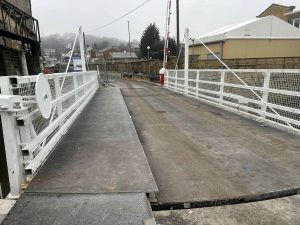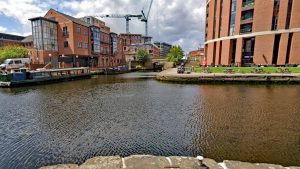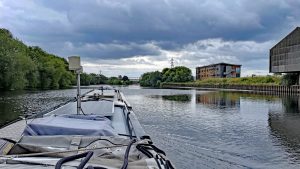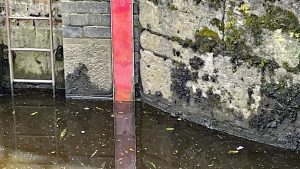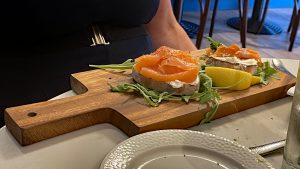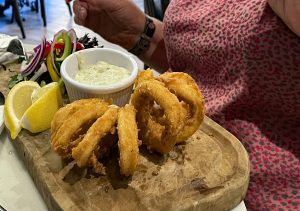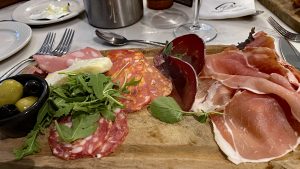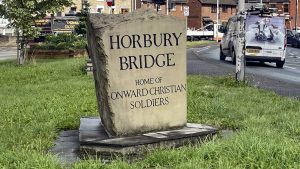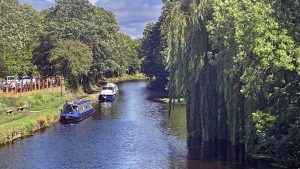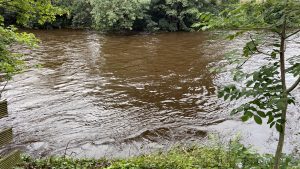From Rodley to Horbury Bridge, Yorkshire
Our first move in July was from Appereley Bridge to Rodley, a short one-hour cruise, two miles with no locks but one swing bridge which put us close to the town of Rodley. A pleasant town with a claim to fame that it would rather not have – the Moss Swing Bridge, you will read more of that later in this blog.
We remained on our mooring close to Rodley for nine days, there was a canal closure in front of us caused by low water levels. We weren’t worried we had plenty of food, and just up the road was a pub owned by a highly regarded local chef, we were looking forward to visiting until we discovered that said chef had got up one morning stated that he was tired of cooking and has never been in the kitchen since. From that day his pub does not provide any food at all. Still there was a very good coffee shop – The Tiny Tea Room – that did great tea, coffee, cakes, ice cream etc that we visited daily.
We left Rodney Visitor Moorings on Monday 10th July, Mark had joined us the day before and Lisa and her dog Roxy joined us for the cruise into Leeds. The very first obstacle was the aforementioned Moss Swing Bridge, built by a private company to allow access to 44 houses they HOPE to get planning permission to build on a flood plain with the bridge as the only access. Following objections from police, fire brigade and local ambulance that the bridge took too long to operate and was unreliable the bridge owners arranged a demonstration where the aging designer was to open and close the bridge to show that it possible for everyone to use it. Reportedly he managed to open it and (with help) to close the bridge, unfortunately when his task was complete, we were told by an attendee that he had a suspected heart attack and an ambulance blue lighted him to hospital. Not long after the gearboxes on the bridge were replaced with lower geared ones to make operating the bridge easier. The bridge owners then employed a team of security guards to attend the bridge 24/7 to instruct (but not help) boaters how to open and close the bridge.
Even with the “help” of the security guards operating the bridge was a nightmare and needed (among other actions) 72 turns of a handle to prepare the bridge to swing, then 110 turns of another handle to actually swing the bridge, then, after the boat has passed through another 110 turns are needed to swing the bridge closed, then another 72 turns of the first handle to get the bridge ready for traffic again. 354 handle revolutions to open and close one bridge!!!!!!
After the joys of Moss Bridge the remainder of the cruise into Leeds city centre was easy peasy, Most of the 12 locks had volunteers operating them and we arrived in Leeds early afternoon and found a mooring in Granary Wharf which is very close to the centre of Leeds. Our exploration of the Leeds and Liverpool Canal complete.
We had intended to stay in Leeds for some days to explore but Mark was only with us a few days so we elected to carry on through the last lock on the Leeds and Liverpool Canal, the aptly named River Lock and venture onto the River Aire.
Having been mucking about on boats since the early seventies I have never been bothered by rivers, one of our first holidays after Sue and I got married was on a hired cruiser on the River Thames and during our years of ownership of a variety of sailing dinghy’s and small yachts have spent many enjoyable hours sailing on rivers (and the sea) both in UK and Europe and during my youth worker years paddled on both flat and white water rivers in canoes, but navigating rivers in a narrowboat is something totally different.
I now hate rivers!
In a canoe you were never alone and could always rely on your companions if things went wrong. In a yacht you always had two means of propulsion so if your engine failed while you were motoring you could always set the canvas and sail on, or of course if the sails, for some reason, could not be set the engine would get you home.
A narrowboat has one engine and one propellor designed to push the boat through the water at around strolling speed and narrowboats have the handling capability of a drowning pig. To mitigate the only one engine problem all river travellers are required to carry an anchor with sufficient chain/anchor rope to enable it to set in an unspecified depth (all our yachts had echo sounders to give a good idea of the depth of water under you and tide tables to give you a good idea of the water speeds). On narrowboats you can research the weight of anchor and a good supplier (e.g. Tradline at Braunston) will give you an idea of the size and length of both needed but it is, at the end of the day, anybody’s guess. Other boaters are happy to add their pennyworth some are worth listening to, some – well!!! Oh yes, it appears that in the (hopefully) unlikely event of a breakdown on a river you chuck the anchor into the river and hope it stops the boat in a safe and easy manner and when you get the engine fixed or some kind soul helps you by giving you a tow to where the engine can be fixed you are, apparently, expected to abandon your anchor equipment as it is said to be virtually impossible to retrieve, then go out and buy another lot. My anchor, chain and warp cost me £360, I would not abandon it.
I hate rivers.
On canals you can moor virtually anywhere, the stern deck is pretty well level with the tow path, you simply stop the boat, step onto the towpath and moor up. On rivers you generally have to continue till you get to a canalised bit, moor up on a convenient bit of bank that may be a long way above the boat deck and you may not be able to get close in so have to use your gang plank or moor up on a lock landing (frowned upon sometimes the only solution).
I hate rivers.
Still as Mark said (he after all lives on a boat moored on the River Soar) “ . . . UK river don’t go into flood in the summer so why worry? – it’s not a problem! . . . ”
We spent the next five days travelling first, the Aire and Calder Navigation then, the Hebble and Calder Navigation. We dropped Mark at a place called Mirfield where the railway station was about 100 metres from our mooring (a canalised section where we had to use our gangplank as the bank was so high and so steep). Our plan was to continue along the Hebble and Calder Navigation till we reached the Huddersfield Canal but guess what the river was “in the red”. Whenever you leave a canalised bit on a navigation and go onto the river proper, there is a tri-coloured depth gauge when the river is in the green section of the gauge it is safe to navigate, when the water level is in the yellow section you can continue with caution, although if you have an accident your insurance company may decide not to payout. When the water level is in the red section of the gauge all flood gates will be closed and you must not navigate. After Mark left we sat on the Mirfield mooring waiting for the river section in front of us to come out of the red. . . In July. . . In the summer.
I hate rivers
The river had dropped into the yellow by the fifth day but during our enforced stay we had researched in a little more detail the route ahead. Our plan had been to continue along the Hebble and Calder Navigation to its junction with the Huddersfield Canal. We would then travel south on the Huddersfield Canal to the Standedge Tunnel. Our boat size is such that we may be over-height to get through the tunnel and, if so, the plan was to return to the Hebble and Calder Navigation and travel west until we reach the Rochdale Canal and then travel south across the Pennines to Manchester when we would plan where we would spend the winter. Our research showed that all three canal routes across the Pennines were closed, the Leeds Liverpool is closed at the Wigan Flight and has been for some while to facilitate repairs to the cill on one of the 21 locks in the flight, while both the Huddersfield Canal and the Rochdale Canal has been closed for much of the summer due to low water levels although one had been re-opened the CRT was saying that they expected it to close soon and that they would try to give seven days notice.
What were we to do now? We needed to be in a marina for the winter but there were very few marinas in the areas accessible to us in the north so we needed to get further south. There was only one option available – the River Trent.
I hate rivers.
Still before we navigate the mighty River Trent we had to get to Keadby. The river in front of us was going down it was out of the red and into the yellow but that was no longer of interest to us as we had to turn around and make our way back the way we came. We got as far as Horbury Bridge (of Onward Christian Soldiers fame) where we found a good mooring close to a few shops restaurants and pubs.We intended to be here for just one or two nights and that evening went out to the Capri Horbury, an Italian restaurant just 100 yards from the mooring, not the cheapest food but very good indeed.
Three fabulous starters, the mains were equally good
The next morning we wandered down the tow path to the next lock which gave access back onto the river, here we noticed a CRT chap and stopped to chat to him, he said that recent rain was causing the river to rise rapidly, it was already in the red and his first task that morning had been to close all the flood gates in his area, he did not envisage the levels dropping sufficiently to reopen the gates for some days – Oh well! Worse things happen at sea.
We saw out the remainder of July without moving. The rain rained. The river level rose. Lisa came to visit we went with her to the Capri Horbury where the meals were as good as those on our first visit, and we contacted Mark and asked if he would be free to crew for us on our River Trent adventure because, have I mentioned before that, I hate rivers.
We are quite comfortable here, there is everything we need close-by, but we are nevertheless anxious to get going.
